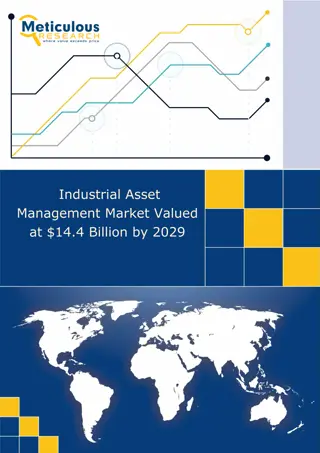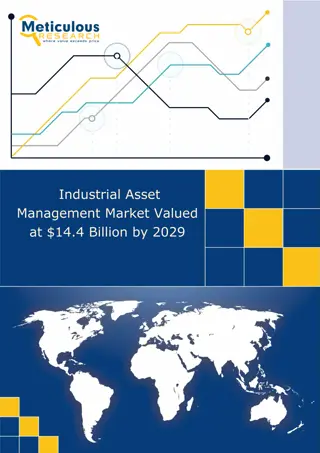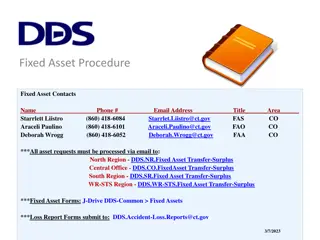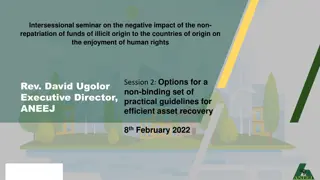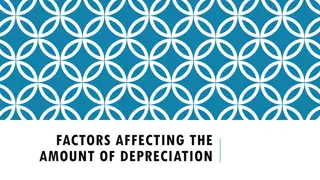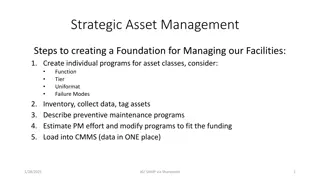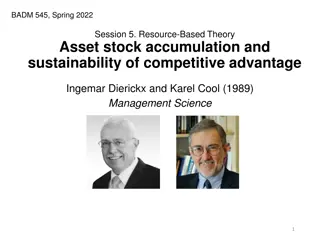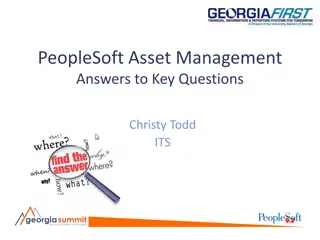
Asset Management Insights from Solvency II Effects and Return on Capital Optimization
Explore the impact of Solvency II regulations on asset management, focusing on the VaR framework, return on capital, risk-free rates, and opportunities for asset managers. Gain insights on value at risk, asset types comparison, European insurance company assets, and the dominance of major players in the industry. Discover the return on capital summaries and the calculation methodology, providing a comprehensive view for making strategic asset management decisions.
Download Presentation

Please find below an Image/Link to download the presentation.
The content on the website is provided AS IS for your information and personal use only. It may not be sold, licensed, or shared on other websites without obtaining consent from the author. If you encounter any issues during the download, it is possible that the publisher has removed the file from their server.
You are allowed to download the files provided on this website for personal or commercial use, subject to the condition that they are used lawfully. All files are the property of their respective owners.
The content on the website is provided AS IS for your information and personal use only. It may not be sold, licensed, or shared on other websites without obtaining consent from the author.
E N D
Presentation Transcript
1 SII effects on asset management CFA UK 31 October 2012 Servaas Houben Maarten Koppenens
2 Agenda The VaR framework Return on capital in Solvency II The current landscape Risk free rate in insurance Spread components Solvency II framework Sovereign credit risk Opportunities for asset managers Return on capital optimisation Hedging and de-risking
3 Mark to market value matters Value at Risk Solvency II suggests 99.5% percentile Over the last 5 years about 1,800 daily returns, 99.5% VaR is the 9th worst daily return Equity looks very risky indeed on this measure Source: UBS
4 A comparison of VaR across asset types Source: Bloomberg, UBS
5 Assets of European insurance companies Source: Bloomberg, UBS
6 The Big 5 dominate - regional asset size Source: Bloomberg, UBS
7 Return on capital - Summary 87% 59% 50% 50% 47% 31% 28% 26% 17% 12% 12% 2 years duration bucket 3% CLOS (Cash SMEs) Equity Property Mortgages Cov AA Corp AA Brazil (BBB) Collateralised Funding (US RMBS AAA) Collateralised Funding (High Yield) Collateralised Funding (FI Securities including CLOs) Corp BBB Corp A 83% 65% 59% 42% 39% 36% 30% 27% 16% 17% 15% 12% 12% 5% 4 years duration bucket 4% 0% 1% RMBS UK (Prime) RMBS Dutch (Prime) India (BBB) CLOS (Cash SMEs) Equity Property Corp AAA Korea (A) Mortgages Corp AA Cov AA Corp A Corp BBB Brazil (BBB) Collateralised Collateralised Funding (FI Securities including CLOs) Collateralised Funding (High Yield) Funding (US RMBS AAA) 39% 29% 28% 25% 21% 21% 6 years duration bucket 17% 13% 12% 12% 9% 1% 1% Russia (BBB) Cov AAA India (BBB) Equity Property Korea (A) Mortgages Corp AAA Brazil (BBB) Corp AA Corp BBB Cov AA Corp A 39% 37% 29% 28% 22% 21% 8 years duration bucket 17% 14% 12% 12% 12% 8% Russia (BBB) Equity Property Cov AAA India (BBB) Mortgages Corp AAA Korea (A) Corp BBB Corp AA Corp A Cov AA The return on capital for an individual asset class is calculated as the return above the minimum guarantee rate of 2.5% divided by the required capital charge for that asset class. Viewed in isolation, the RoC of an individual asset class is a straightforward indicator of its attractiveness. However, in the context of the portfolio, the RoC of the entire portfolio does not necessarily consist of the asset classes with the highest RoC, due to the effects of aggregating the return and the charge. Source: UBS
8 Solvency Capital Requirement Assumptions 47% 1-3 years maturity bucket 25% 14% 14% 14% 6% 5% 3% 3% 3% 3% 3% 2% 2% 2% 2% 1% 1% 3% Collateralised Funding (High Yield) Cov AAA Corp AAA Cov AA Korea (A) Corp AA Collateralised Funding (US RMBS AAA) Collateralised Funding (FI Securities including CLOs) Russia (BBB) India (BBB) Corp A Brazil (BBB) Corp BBB Mortgages RMBS UK (Prime) RMBS Dutch (Prime) CLOS (Cash SMEs) Property Equity 47% 28% 28% 28% 25% 3-5 years maturity bucket 10% 6% 6% 6% 6% 6% 4% 4% 4% 4% 3% 3% 3% 1% Collateralised Funding (High Yield) Collateralised Funding (US RMBS AAA) Collateralised Funding (FI Securities including CLOs) Cov AAA Corp AAA Cov AA Corp AA Korea (A) Russia (BBB) India (BBB) Corp A Brazil (BBB) Mortgages Corp BBB Property RMBS UK (Prime) RMBS Dutch (Prime) CLOS (Cash SMEs) Equity 47% 25% 5-7 years maturity bucket 14% 8% 8% 8% 8% 6% 6% 6% 5% 5% 4% Cov AAA Cov AA Corp AAA Mortgages Corp AA Korea (A) India (BBB) Russia (BBB) Corp A Brazil (BBB) Corp BBB Property Equity 47% 25% 7-10 years maturity bucket 17% 9% 9% 9% 7% 7% 6% 6% 6% 5% Cov AAA Mortgages Cov AA Corp AAA Corp AA Korea (A) India (BBB) Russia (BBB) Corp A Corp BBB Property Equity The SCR on equity is assumed to be the average between the SCR for OECD listed (39%) and non-listed equities, private equity and hedge funds (49%). No symmetric adjustment taken into account.
9 Return assumptions 550 300 1-3 years maturity bucket 150 100 85 80 38 40 30 21 0 Corp AAA Brazil (BBB) Collateralised Funding (High Yield) Cov AA CLOS (Cash SMEs) Collateralised Funding (US RMBS AAA) Collateralised Funding (FI Securities including CLOs) Mortgages Corp BBB Property Equity 550 300 3-5 years maturity bucket 175 208 170 110 100 100 92 50 30 18 9 Korea (A) RMBS Dutch (Prime) Corp A Collateralised Funding (High Yield) Cov AA Mortgages Collateralised Funding (US RMBS AAA) Collateralised Funding (FI Securities including CLOs) CLOS (Cash SMEs) Corp BBB Brazil (BBB) Property Equity 550 300 5-7 years maturity bucket 207 192 130 100 52 13 0 Corp AAA Korea (A) Corp A Mortgages Cov AA Brazil (BBB) Corp BBB Property Equity 550 300 242 215 7-10 years maturity bucket 139 122 100 49 30 30 Cov AAA Russia (BBB) Corp AA Mortgages Corp A Korea (A) Cov AA Corp BBB Property Equity Source: UBS
10 Risk free rate concept - 1 Several options for risk free curve: Swap curve with credit adjustment Government curve Corporate bond curves Collateralised AAA curves Swap curves and government curves are most common, but are they also truly risk free?
11 Risk Free Curves Snapshot of market and Solvency II curves 3.50% EUR / 24 August 2012 / Spot / Annual EUR 24 August 2012 3.00% 2.50% 2.00% Market LIBOR Market OIS Solvency II Risk Free 1.50% 1.00% 0.50% 0.00% Source: Bloomberg 1 11 21 31 Term (Years) Risk Management Hedging uses assets quoted on OIS Pricing (Guarantees) Funding for hedging based on OIS Provisioning Solvency II based on LIBOR & UFR One-off surplus (based on current market environment) Hedging efficiency and provisioning risk due to LIBOR-OIS basis
12 Risk free rate concept - 2 Swiss frank compared to other currencies 12 1.8 1.6 10 1.4 CHF per GBP/USD 8 1.2 CHF per Eur 1 6 0.8 4 0.6 0.4 2 0.2 0 0 Jan-71 Jan-76 Jan-81 Jan-86 CHF per GBP Jan-91 Jan-96 Jan-01 EUR per CHF Jan-06 Jan-11 Date USD per CHF Loss in value compared to Jan 1971 levels: GBP: 86%, 4.7% p/a USD: 78%, 3.6% p/a Loss euro compared to Jan 1999 level: 24%, 2.1% p/a Source: Bloomberg
13 Spread components Spread = yield corporate bonds risk free yield Credit risk factors: Expected default Spread widening Downgrade/transition Non credit risk factors: Tax Regulatory Liquidity
14 Solvency II & Basel III spread assessment Solvency II favours EEA government debt over other forms of sovereign debt Basel III does not make this EEA/non EEA distinction Solvency II sovereign categorisation Issued in domestic currency Issued in non-domestic currency EEA government bonds None Level 2 text: Article 156.3 high charge Non-EEA government bonds Level 2 text: Article 163 SR7.4 low charge Level 2 text: Article 156.3 high charge Issues regarding the standard formula: No capital requirement EEA government/CDS exposure No inclusion in default risk module Preferential treatment of government bonds
15 Differentiation EEA governments 1 Yield as per 1 Jan 2006 4.5 4 Yield: Ger, Fra, Gre, Bri 3.5 3 2.5 2 - 5 10 15 20 25 30 Term in years Germany France Greece Britain Source: Bloomberg
16 Differentiation EEA governments 2 Yield as per 14 Feb 2012 4 450 400 3.5 350 3 Yield: Ger, Fra, Bri 300 Yield Greece 2.5 250 2 200 1.5 150 1 100 0.5 50 0 0 - 5 10 15 20 25 30 Term in years France Germany Britain Greece Source: Bloomberg
17 Differentiation EEA governments 3 CDS development 250 4,000 3,500 200 CDS premium Ger, Fra, Bri 3,000 CDS premium Gre 2,500 150 2,000 100 1,500 1,000 50 500 - - 31/01/2006 15/06/2007 27/10/2008 11/03/2010 24/07/2011 date France Germany Britain Greece Source: Bloomberg
18 Conflicts of interest government yield curve Government can avoid default In case of default local regulator is under pressure to write down liabilities in line with the loss in value of local government bonds Regulator Policyholder security National interest, stability, political motives Insurance company Government Pressures government to reduce liabilities
19 Default definition what s in a name? Dominic Republic 2005: Recovery rate on defaulted bonds 95% Rating agencies verdict: default Zimbabwe 2006: Annual inflation rate: 1,216% p/a Rating agencies verdict: no default Angola 1996: Annual inflation rate: 4,416% p/a Rating agencies verdict: no default Default and re-scheduling Default and re-scheduling 1800-24 1800-24 1825-49 1825-49 1850-74 1850-74 1875-99 1875-99 1900-24 1900-24 1925-49 1925-49 1950-74 1950-74 1975-2006 1975-2006 Africa Africa NA NA NA NA 1 1 1 1 1 1 0 0 1 1 21 21 Asia Asia NA NA NA NA NA NA NA NA 1 1 2 2 4 4 7 7 Europe Europe 13 13 9 9 7 7 5 5 2 2 12 12 0 0 7 7 Latin America Latin America NA NA 15 15 10 10 22 22 13 13 18 18 11 11 36 36 Reinhardt & Rogoff
20 Limitations rating agency data Lack of historical data: are the Probability of Default and Recovery Rate robust? Changing data set over time: historical average not reflecting future risks Lack of transparency: how to compare different 1-year PDs? Difference local and foreign defaults No historical 1 year PD for investment grade (BBB and higher) Lowest rating is mixed bag Moody's distribution sovereign issuer ratings 100% 90% 80% 70% 60% 50% 40% 30% 20% 10% 0% 1983 1990 1995 2000 2005 2010 Aaa Aa A Baa Ba B Caa-C Moody s
21 Matching Premium Draft Level 2 Text Methodology Qualifying Liability Matching Premium Spread No future premium allowed. = IRR on Asset portfolio - Fundamental Spread - IRR on liability cashflows (discounted using Solvency II risk free rate.) Underwriting risk covers only longevity, expense and revision risks No option for surrender or only a surrender option where the surrender value does not exceed the value of the assets. Fundamental Spread = MAX (Minimum Fundamental Spread, Expected Default) Expected Default = Probability of Default x LGD + Marked to Market due to a rating downgrade Minimum fundamental spread = 75% of Long Term Average Spread Assumptions Qualifying Assets Our analysis assumes: Ring fenced from other insurance portfolio Long Term Average Spread by rating and term can be derived from the iBoxx GBP Corporate Bond Index spread history. Same currency as liability. Cashflow matched to liability cashflows. Fundamental Spread is equal to 75% of Long Term Average Spread. Cashflows of the assets are fixed cannot be changed by the issuer or any third parties. (Except for Inflation linked instruments matching inflation linked liability) Assets are invested in the same index constituents by rating and term as the relevant iBoxx indices. Investment grade bonds only Limited to a maximum investment of 30% in BBB bonds Limited to a maximum investment of 15% in BBB for bonds which are purchased after 31-Dec-2012
22 Matching Adjustment Draft Long Term Guarantee Assessment Matching Adjustment (previously known as Matching Premium) is split into Classical Matching Adjustment and Extended Matching Adjustment . Classical Matching Adjustment (Article 77c) Same as the draft level 2 text Matching Premium approach. No future premium Underwriting risk covers only longevity, expense and revision risks No option for surrender or only a surrender option where the surrender value does not exceed the value of the assets. Extended Matching Adjustment (Article 77e) The insurance company can apply a portion of the matching adjustment to the portfolio which remains matched under stressed situations. Allows future premium Underwriting risk covers only longevity, expense, revision, lapse and disability recovery risks. Key Impact this widens the scope for applying matching premium to insurance liabilities other than UK and Spanish annuities. Insurance liabilities which previously were discounted using the risk free curve may be eligible for discounting at a higher yield than risk free yield. Assessment for Cashflow Mismatch There will be a breach if one of these 2 conditions is not met for liability cashflows < last liquid point: a) sum of cashflows < sum of liability cashflows per bucket (monthly, quarterly, semi annually or annually) b) company unable to provide evidence that any mismatch shall not jeopardize the timely payment of benefits Admissible assets The limit on BBB rated bonds is 33.33%, excluding member state government bonds. Make-whole clauses on callable bonds are eligible. Cashflows of a single asset cannot be split into admissible & inadmissible parts. Fundamental Spread Some preliminary fundamental spread was presented for GBP and EUR corporates grouped by ratings, sectors and duration bands. SCR Treatment Under the SCR module, the increase in spread assumed in the spread SCR module can be passed on the discounting of liability as well. This means that the liability value may be reduced under the matching adjustment treatment leading to a lower spread SCR when holding credit. Transitional Measure It appears that if the matching adjustment treatment is elected then the transitional measure would no longer apply.
23 Proposed Scenarios for the Quantitative Assessment I - Adapted relevant risk-free interest rate term structure IV - Article 77e Matching adjustment No adaptation No Matching Adjustment Standard adaptation Matching Adjustment using standard adaptation for lapse risk 50% of standard adaptation risk Matching Adjustment using alternative adaptation for lapse 200% of standard adaptation Standard adaptation only for liabilities w/ duration > 7 yrs II - Extrapolation V - Transitional Measures QIS5 with LLP of 20 yrs for EUR No transitional measure LLP 20yrs for EUR, 40 yr convergence Transitional measure applied to all existing business LLP 20yrs for EUR, 10 yr convergence Transitional measure applied to paid in premiums only III - Article 77c Matching adjustment VI - Scenarios No Matching Adjustment Reference date 31 December 2011 Matching Adjustment Reference date 30 June 2012 Reference date 31 December 2010 Reference date 31 December 2004 Prolonged low interest rate environment for 7 years
24 Matching Premium vs Liquidity Premium (1) Historic Comparison of iBoxx EUR Corporate A 10Y Matching Premium vs QIS 5 Liquidity Premium QIS 5 Liquidity Premium Matching Premium QIS5 Liquidity Premium (currency) Matching Premium (rating, term, currency) = 50% x MAX (iBoxx Corporate Spread (currency)- 40bps, 0) = 100% x [iBoxx Corporate Spread (rating, term, currency)- Fundamental Spread (rating, term, currency)] Varies by currency and rating Varies by currency Dependent of assets held Independent of assets held Varies by maturity term. Is fixed for the first 30 years of maturity and then set to 0. Can be negative. Floored at 0 Matching Premium for BBB corporate is capped at the AA or A level. 3. Post 2007 Matching Premium exceeds QIS 5 Liquidity Premium due to spread widening. 1. Low spread environment generates a negative matching premium when the spread falls below the fundamental spread. 2. Pre 2007 - Matching Premium is below the QIS 5 Liquidity Premium. Source: UBS Delta 24-Nov-2011
25 Matching Premium vs Liquidity Premium (2) Historic Comparison of iBoxx EUR Corporate 10Y Matching Premium vs QIS 5 Liquidity Premium by rating iBoxx EUR AAA 10Y Corporate iBoxx EUR AA 10YCorporate Temporary spike in spread due to GE downgrade from AAA to AA Matching Premium for BBB bonds is effectively floored at the AA level regardless of the spread on the BBB bonds. QIS 5 Liquidity Premium is fixed and independent of the rating of the bonds invested. Source: UBS Delta 24-Nov-2011 Source: UBS Delta 24-Nov-2011 iBoxx EUR A 10YCorporate iBoxx EUR BBB 10Y Corporate Source: UBS Delta 24-Nov-2011 Source: UBS Delta 24-Nov-2011
26 Sample Matching Premium Calculation iBoxx Corporate Index Based on our understanding of the likely proposal for Matching Premium, we have provided an estimate of the matching premium by rating and maturity term. Long Term Average Spread = Average Z Spread on iBoxx Indices. iBoxx Corporate Spread = Z Spread to Swap Curve Note that there is no history prior to the inception of iBoxx indices back in 1999. Source: UBS Delta 24-Nov-2011 Source: UBS Delta 24-Nov-2011 Matching Premium Estimate= Fundamental Spread = iBoxx Corporate Spread Fundamental Spread Matching Premium for BBB bonds is effectively floored at the AA level . Hence the overlapping line for BBB and AA corporates. 75% x Long Term Average Spread Source: UBS Delta 24-Nov-2011 Source: UBS Delta 24-Nov-2011
27 About us Servaas Houben heads the risk scenario generation team at Prudential, London. He studied econometrics in the Netherlands and worked in life insurance for the first four years of his career. Following this, he worked in Dublin and London. Besides actuarial, Servaas completed the CFA and FRM qualifications, and regularly writes on his blog, for CFA digest and Dutch actuarial magazines. Email: servaashouben@gmail.com Blog: http://actuaryabroad.wordpress.com Tel: +44 (0) 207 548 2774 Maarten Koppenens joined UBS in April 2010 and is responsible for Dutch insurance solutions focusing on accounting and regulatory frameworks, liability management and optimalisation of asset allocation. Prior to joining UBS, Maarten worked at Swiss Re as a marketing actuary focusing on de-risking of insurance liabilities. Besides being a qualified actuary, Maarten holds a degree in econometrics and an MBA. Email: maarten.koppenens@ubs.com +44 (0) 207 567 4357
28 References & contact details Churm & Panigirtzoglou, Decomposing credit spreads, Bank of England working paper no 253 Kahneman, Thinking fast and slow, 3 November 2011 Moody s, Corporate Default and Recovery Rates, 1983-2010, February 28, 2011 Moody s, Narrowing the gap a clarification of Moody's approach to local versus foreign currency government bond ratings, February 2010 Moody s, Sovereign Default and Recovery Rates, 1983-2010, May 10, 2011 Reinhart & Rogoff, This time is different: A Panoramic View of Eight Centuries of Financial Crises, April 16, 2008 Remolona, Scatigna, Wu, A ratings-based approach to measuring sovereign credit risk, International Journal of Finance and Economics volume 13 (2008) S&P, Sovereign Defaults And Rating Transition Data, 2010 Update, 23 Feb 2011 Webber bank of England, Decomposing corporate bond spreads, 2007Q4






